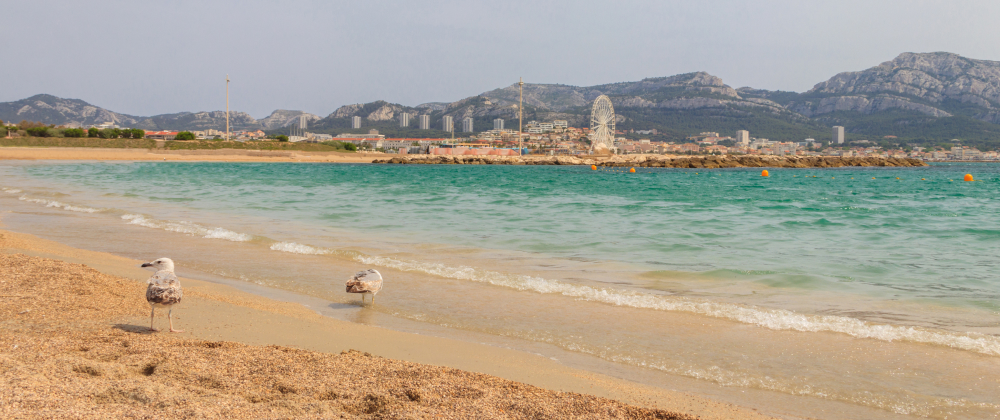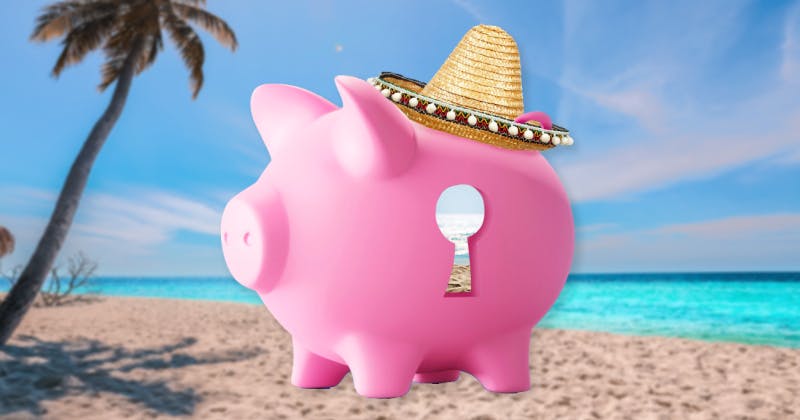
Marseille Travel Guide
Published by
Holiday Extras on
Edited on
A warm Mediterranean climate, historic neighbourhoods full of life and a postcard-ready coastline await you in Marseille. Do as the French do and head here for the perfect blend of city break and beach holiday.
What you'll find in this guide:
Top things to do in Marseille
Practical Information
Marseille weather
Best time to visit Marseille
Getting to Marseille
Getting around Marseille
Where to stay in Marseille
Marseille highlights
Marseille for families
Marseille food
Accessibility in Marseille
LGBTQI+ travel in Marseille
Sustainable tourism in Marseille
Marseille FAQs
GMT +2
Euros EUR
French
Type C & E
2 hours
Some facts about Marseille
Paris may be France's largest city, but Marseille is the oldest. The port city was founded around 600 BC by Greek sailors and traders from Phocaea (now Foça, in modern Turkey), who first called it Massalia. Thanks to Marseille's coastal location it quickly became a melting pot of French, North African, Italian and Corsican cultures as immigrants moved in from all over the world, making it arguably the country's most diverse city.
It's fair to say France's rough and ready second city has built up a bad reputation in recent years – its high crime rate has led many to call it one of Europe's most dangerous cities. But nowadays it's one of the coolest spots in the country for a weekend away and a favourite of Parisians looking for sun, beaches and an amazing bite to eat. It's the home of bouillabaisse, a must-try Provençal fish stew best served with gorgeous Mediterranean Sea views. Lucky thing Marseille's got plenty of those.
Practical Info
Culture and etiquette
Religion
Marseille is very diverse when it comes to religion. The majority of people are Christian, but there's a large Muslim and Jewish population too.
Tipping
Do you need to tip in Marseille? Tipping in bars and restaurants isn't expected in Marseille, and a service charge of around 15% is usually included in the bill anyway. Feel free to leave a little tip if the service has been particularly good, but you can leave your tip-based worries at home.
Smoking
Smoking is banned in all indoor public places, including bars, restaurants, museums and public transport.
Language
Believe it or not, the main language you'll hear walking around Marseille is French. Plenty of locals at tourist sites, bars and restaurants speak English, but it's a good idea to brush up on your French just in case.
Helpful French phrases:
- Hello – Bonjour
- Goodbye – Au revoir
- How are you? – Ça va?
- Yes – Oui
- No – Non
- What's your name? – Comment t'appelles tu?
- My name is – Je m'appelle
- Please – S'il vous plaît
- Thank you – Merci
- How much is it? – C'est combien?
- Where is? – Où est?
- Numbers:
- One – Un
- Two – Deux
- Three – Trois
- Four – Quatre
- Five – Cinq
Jabs, visas and other advice
For up-to-date advice on jabs, visas and other foreign advice, we recommend following the government's website.
Emergency numbers
For any emergency you can call 112.
What's the weather like in Marseille?
Summer in Marseille is hot, with temperatures peaking from 25 to 30 °C between June and August. That'll explain why it's so crowded, as in-the-know French tourists flock to the beach to catch some rays and live the high life. Sounds pretty ideal to be fair.
The shoulder seasons aren't too bad either if it's warm weather you're after. April, May, September and October often reach into the balmy mid-20s, which is still warm enough for a dip in the Med but not so warm that your ice cream melts in seconds. Bring a brolly just in case, as rain isn't uncommon – particularly in autumn.
Winter's another matter. November to March isn't cold compared to the UK, but don't expect temperatures to climb much higher than 12°C. The coastal winds help make that feel a fair bit colder, so add a jumper or two to your suitcase.

When's the best time to visit Marseille?
Most tourists head to Marseille in the height of summer and it's easy to see why. The weather's scorching, making it the best time to laze about on the beach, and festival season and outdoor parties are in full swing. Head there in June for live jazz and garlic markets, July for Marseille Pride and Bastille Day, and August for the start of the football season and the Cassis wine harvest.
The heat's perfect for the beach, but can be a bit much for sightseeing. The shoulder seasons in April, May, September and October are probably the best times to walk around the city and take in everything it has to offer. You won't overheat but can still spend a comfortable day at the beach, plus everywhere will be less crowded. If you're travelling in spring, April's sailing season, so there'll be plenty of white sails making the coastline even more picture-perfect, while May's when the open-air food markets start to arrive. For autumn, September's perfect for exploring the nearby Calanques National Park and October marks the end of the season and offers warm weather without the crowds.
For those on a budget wanting to explore Marseille's excellent museums and cultural attractions in peace, the off-season could be a good bet. Sure it's not exactly beach weather, but since the cold winds scare most tourists away it'll feel like you have the city to yourself. And as a bonus, accommodation is much cheaper this time of year. November to January is the time to visit for Marseille's oldest craft fair, Foire aux Santons, with traders selling mini terracotta figurines called santons that are traditionally put in Christmas cribs. Don't fancy that? Try February for oursin season, when sea urchins will be on pretty much every menu, or March for the lively and colourful Carnaval de Marseille.
TopGetting to Marseille
The quickest way to get to Marseille from the UK is to fly. It takes around two hours from London, and there are loads of aircraft options from budget to bougie.
Marseille Provence Airport is where you'll fly to, which is about a 25-minute drive from the Vieux Port in the heart of Marseille. You could book yourself an airport transfer beforehand to save yourself some time, or if you're hiring a car you can pick it up at the airport. You could take a taxi from just outside Terminal 1, but they tend to be quite pricey. Buses run from here too, taking you from the airport to Saint-Charles station in under 50 minutes.
Flying isn't the only way to get to Marseille – you can drive all the way there if you like. Take LeShuttle from Folkestone to Calais, or the ferry from Dover, and from there it's a long but scenic 10-hour drive to Marseille. The quickest route is along the A26 and A7 and passes through Troyes, Lyon and Avignon, or take the A6 and A7 if you want to visit Paris on the way.
If driving sounds like a bit too much effort, take the train instead. Board the Eurostar from London to Paris, stop off for a croissant, crêpe or Champagne, then hop on the high-speed service that'll get you to Marseille in around three hours. Trains are much better for the environment than flying and driving, plus you'll get to enjoy gorgeous views of the French countryside along the way. How lovely would that be after a glass of fizz or two in Paris?
Marseille is also a great place to visit as part of a cruise, which means you could float through Barcelona, Naples, Valletta and more as part of the same trip. Marseille Provence Cruise Terminal is the main port, which is around a 20-minute drive from the airport and 25 minutes from the city centre.
Getting around Marseille
You made it to Marseille – hourra! But now you're there, what's the best way to get where you need to go?
The short answer is to walk. Most of the areas we'd recommend tourists to visit – Le Panier, Vieux Port, Noailles and Notre-Dame-du-Mont – are fairly close to each other, making it possible to walk between most of Marseille's top attractions.
Old parts of the city like Le Panier have quite steep streets, so walking everywhere might not be suitable for everyone. Thankfully Marseille boasts two metro lines, three tram lines and 80 bus routes to save your legs from getting too tired. You can buy tickets at any metro station or somewhere displaying an RTM sign – save yourself some money and go for one-day, three-day or weekly passes if you plan on using public transport a lot.
Bringing a car? To be honest Marseille is a pretty rubbish city to drive around given the narrow streets, lack of parking and erratic traffic, so we'd suggest leaving the car behind when heading into the city centre. Taxis can get you there if needs be – you'll be thankful to have someone who is used to the roads in Marseille to drive you around.
For those planning on leaving Marseille and exploring other areas of France, that's when it pays to bring a car. The drive along the French Riviera from Marseille is stunning, taking you through Toulon, Saint Tropez, Cannes, Nice and all the way to Monaco. You can travel much of this route by train too if you don't fancy driving.

Top

France ranks 21st on the Good Trip Index
This score is calculated based on Sustainability, Human Rights, Women's Rights, Press Freedom, Quality of Life, LGBTQI+ Rights and Animal welfare
Find out moreWhere to stay in Marseille
Vieux Port
At the heart of the city, the Vieux Port (Old Port) is a picturesque harbour filled with cafes, seafood restaurants and bars. Staying here means you're close to most of the city's attractions, like the MuCEM (Museum of European and Mediterranean Civilisations), Le Panier district and Notre-Dame de la Garde. For first-time visitors heading to Marseille it's hard to recommend staying anywhere else.

Le Panier
Just north of the Vieux Port, Le Panier is the oldest neighbourhood in Marseille. Its narrow streets, quaint shops and artistic vibe make it a charming place to explore. The area is known for its historical buildings and cultural sites and is ideal for travellers looking for a lively area to stay.
La Corniche
If you're looking for sea views and a slightly quieter stay, La Corniche is a scenic waterfront road lined with beaches, cafes and luxury hotels. It's a great area to experience the coastal side of Marseille, with easy access to beaches like Plage des Catalans. It's ideal for couples looking for a quiet, romantic getaway.
Plages du Prado
Ideal for families or those looking to relax, this area boasts excellent parks like Parc Borély and the Prado beaches. It's less central than other districts but offers a peaceful retreat.
Marseille highlights
Explore the Vieux Port
Yes we're banging on about the Old Port again and we're not even sorry. Start your trip by exploring the historic heart of Marseille and enjoy the lively atmosphere, watch the fish market and taste all the fresh seafood you can. Could life be better? Doubt it.
Visit Notre-Dame de la Garde
Dominating the city's skyline, this basilica offers stunning 360-degree views over Marseille and the sea. It's a bit of a climb, but the vistas and the architecture are absolutely worth it.

Wander through Le Panier
Stroll through the narrow streets of Marseille's oldest neighbourhood, filled with charming shops, colourful murals and quaint squares. Look out for La Vieille Charité, a cultural complex that often hosts art exhibitions.
Discover MuCEM (Museum of European and Mediterranean Civilisations)
This striking museum is dedicated to Mediterranean culture and history, with both permanent and temporary exhibitions. The building itself is a modern architectural marvel, linked to the historic Fort Saint-Jean.
Relax at the beach
Head to the Prado Beaches or the more secluded calanques (rocky inlets) like Calanque de Sormiou or Calanque de Morgiou for a swim in the crystal-clear Mediterranean waters. Lovely.

Shop at Noailles Market
Visit the bustling Noailles market to immerse yourself in the sights, sounds and smells of this diverse and lively neighbourhood. It's known for its African and Asian influences, making for a unique shopping experience.
Seek out the street art
Make sure to visit Cours Julien, a neighbourhood known for its vibrant street art, boutiques and cafes.
TopMarseille for families
Marseille is a great place for families to visit. Combine all the amazing sights around the Vieux Port with an ice cream and everyone will be more than happy. You could take Le Petit Train de Marseille for a sightseeing tour of the city, which is a great way to see Marseille's top attractions without having to walk further than little legs allow.
And then there are family-friendly stretches of sand like Plage des Catalans and the Prado beaches, which have playgrounds, volleyball courts, picture-perfect picnic spots and plenty of space to dig the biggest hole in the sand you've ever seen. Kids still do that, right? If not, rent a kayak or paddle board and take to the Mediterranean waters, or if that sounds like too much effort throw a tablet at them and enjoy a nice seafront meal in relative peace.
What to eat in Marseille
Being on the coast, many of Marseille's best culinary treats are from the sea. No visit is complete without trying bouillabaisse, the famous local fish stew, with many restaurants offering their own take on this traditional dish.
There's plenty more to try in Marseille. Seek out navettes, which are small, boat-shaped biscuits with a hint of orange flower water and traditionally associated with the feast of Candlemas. Marseille makes an excellent aïoli too, a moreish garlicky sauce usually served with vegetables, eggs and fish.
You'll want something to wash all that down with, and little beats a rosé wine from Provence for that kind of job. The crisp, dry rosé found around Marseille pairs perfectly with the warm Mediterranean climate that's more than likely to greet you.

Accessibility in Marseille
Most of the top sights in Marseille are accessible to wheelchairs, including the Basilica of Notre-Dame de la Garde, but it's worth checking with the attraction before you go. Older parts of the city like Le Panier can be challenging to navigate as there are lots of steep steps and big crowds, so it's best to bring someone with you if you have any accessibility needs.
Accessible buses with ramp access circle around the city, but check the route map carefully to make sure the bus you're waiting for is accessible. Trams are accessible and have waist-high buttons to let the driver know you want to get off, and there are spaces on the metro for people with limited mobility as well as lifts to reach the platform.
Marseille for LGBTQI+ travellers
France historically has been one of the most progressive countries for LGBTQI+ rights. The country legalised same-sex relations as far back as 1791, same-sex marriage in 2013 and allowed transgender people to change their gender identity without the need for surgery or a medical diagnosis in 2017.
While there's no defined LGBTQI+ district in Marseille, there are plenty of gay venues scattered throughout the city. Marseille Pride usually takes place in July and features a colourful parade, festival and plenty of parties.
Sustainable tourism in Marseille
While it would be very difficult to travel to Marseille and not have any impact on the environment, there are a few things you can do to minimise your carbon footprint. Instead of flying, why not take the train? Taking the Eurostar from London to Paris emits 96% less emissions than by plane, and from there you can catch the energy-efficient high-speed line to Marseille.
When looking for somewhere to stay in Marseille, look out for accommodation with Green Key accreditation, which recognises hospitality businesses that are committed to sustainable practices. And for something to eat, try restaurants with the Écotable label and shop local where you can. There are lots of amazing markets that showcase local Marseillais products, many of which have travelled a much shorter distance than similar produce found in supermarkets and big chains.
TopMarseille FAQs
Is Marseille safe to visit?
It's fair to say Marseille doesn't have a great reputation when it comes to safety. Its high crime rate compared to other major cities in Europe, as well as its history as a drug trafficking hub, has led many to call it one of Europe's most dangerous cities. But is this a fair assessment?
Despite its reputation Marseille remains a very popular destination to travel to, especially for French tourists, and you're unlikely to run into trouble when visiting the main tourist areas like the Vieux Port, Le Panier and La Corniche. Like most major cities, pickpocketing can be an issue in crowded tourist areas and public transport, so be aware of your surroundings and keep your belongings safe when you're out and about.
How many days do I need to explore Marseille?
For a relatively quick visit that covers the main highlights, we think 3 days in Marseille would be pretty ideal. This would give you time to explore the main sights in the Vieux Port and Le Panier, take in Notre-Dame de la Garde and the best of La Corniche coastal road or even explore Calanques National Park.
For those wanting to see more of Marseille, 4 or 5 days would give you time to see the Frioul Islands and Château d'If, relax at Marseille's best beaches or head to a nearby vineyard to try some Provençal wine.
What are the best beaches in and around Marseille?
Plage des Catalans is one of the closest beaches to the city centre, which also makes it one of the most popular. This sandy beach is fairly small so tends to get crowded in peak season. There's also Plage du Prado, which is a large, artificial sandy beach that's popular with families thanks to facilities like volleyball courts, skate parks and nearby parks.
For watersports head to Plage de la Pointe Rouge, a sandy beach that's perfect for windsurfing and sailing. Or for somewhere a little more secluded, head south of Marseille to Calanques National Park, whose coastline features dramatic limestone cliffs and hidden bays for the most picture-perfect of beaches.
Top

























